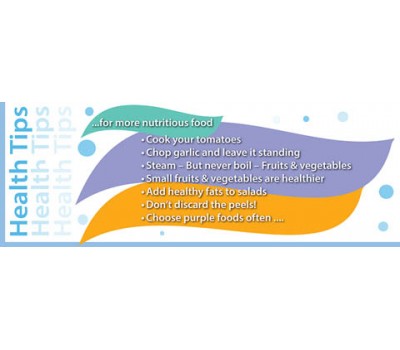10 Tips For More Nutritious Food

Trying to get the most nutrition out of your food? That’s a really good idea in this day and age.
Below, we’ll explain 10 simple ways so that you can squeeze more nutrients from common food items that are already in your kitchen and diet.
And don’t worry – none of these “food hacks” require hours of work or an advanced science degree. They’re just simple, research-based tips that just about anyone can implement at home. Ready?
1. Cook Your Tomatoes
Raw food isn’t always more nutritious than cooked food. Tomato paste and tomato sauce, for example, contain more lycopene than raw tomatoes.
Cooking actually enhances the lycopene content.1
2. Chop Garlic and Leave it Standing for Ten Minutes
This helps to generate allicin, a cancer-fighting compound.2, 3 And if you dare, eat your garlic raw. Cooking literally destroys this beneficial compound!
3. Steam – But Never Boil – Fruits and Vegetables
Steaming, in certain cases, may enhance the nutrient content of certain foods (carrots, for example), while boiling destroys them.
For this reason, a steam basket is the best way to cook your favorite vegetables.
4. The Smaller the Fruit or Vegetable, The Healthier
As a general rule of thumb, smaller fruits and vegetables tend to be more nutritious than their larger counterparts.
One great example is cherry tomatoes. They easily beat other tomato varieties when it comes to their lycopene content.4
5. Add a Healthy Source of Fats to Your Salads
If you want to absorb the nutrients from your salad, add vegetable oil or avocado slices. According to research, this helps your body absorb beneficial nutrients, such as beta-carotene.5
6. Don’t Discard the Peels!
The peels of fruits and vegetables often contain more nutrients than the flesh itself. Onion peels, for example, contain more quercetin, a cancer-fighting antioxidant, than the flesh.6
Save onion peels to make vegetable broths. They’re packed with nutrients!
7. Add Lemon Juice
Here’s a neat little trick: if you add lemon juice to green tea, it enhances the absorption of catechins, the beneficial antioxidants found in green tea.7
Lemon juice also helps to prevent avocados, apples, and bananas from browning.
8. Add Probiotics
Probiotics nourish your gut with beneficial bacteria which not only help the absorption of nutrients but convert them into disease-fighting compounds. An example is found in flax seeds.
Gut bacteria convert beneficial flax lignans into enterodiol and enterolactones, two compounds that fight hormone-related cancers.8,9
9. Don’t Buy Pulp Free Juices!
The pulp from fruit contains beneficial fiber and antioxidants. Orange pulp, for example, is a great source of heart-healthy naringin and hesperidin.10
10. Choose Purple Foods Often
Our favorite fruits and vegetables often come in different colors. For example, you’ll find white potatoes and purple potatoes, green kale and purple kale, and so forth. The purple color is a reflection of their anthocyanin-content.
Research shows purple potatoes contain more polyphenols than conventional kinds, and they’re less likely to increase blood sugar levels.11
Try them if you can find them at your local supermarket!
References:
- 1. Nutr Hosp. 2012 Sep-Oct;27(5):1542-6.
- 2. Molecules. 2014 Oct 31;19(11):17697-714.
- 3. J Agric Food Chem. 2007 Feb 21;55(4):1280-8.
- 4. J Sci Food Agric. 2005 Sep; 85(12):2021-2026.
- 5. J Nutr. 2005 Mar;135(3):431-6.
- 6. J Nutr Sci Vitaminol (Tokyo). 2007 Feb;53(1):21-9.
- 7. Mol Nutr Food Res. 2007 Sep;51(9):1152-62.
- 8. Am J Clin Nutr. 1999 Mar;69(3):549-55.
- 9. J Med Food. 2013 Apr; 16(4): 357–360.
- 10. Asian-Australas J Anim Sci. 2014 Aug;27(8):1104-13.
- 11. Food Funct. 2014 May;5(5):909-15.
Article extracted from Life Extension Blog March 2015


Social Login